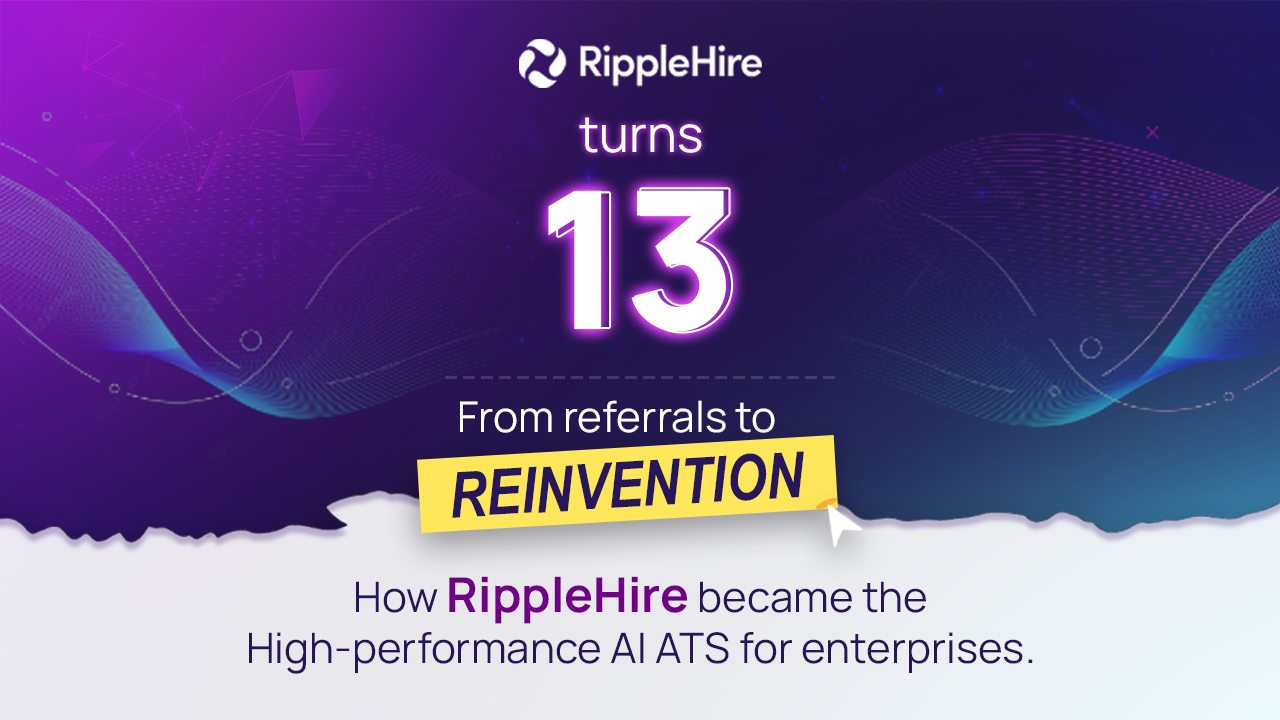How To Track ROI On Your Recruitment Drives
Big hiring drives can feel successful just by the volume of candidates interviewed. But unless you measure outcomes, it’s hard to know if the effort was worth it.
Tracking the ROI of your recruitment drives gives you the ability to see whether the investment is leading to better quality hires, faster closures, and reduced costs. In this guide, we’ll break down what ROI in recruitment really means, the kind of data you should capture, and how to use it to improve hiring outcomes at scale.
Why tracking ROI in recruitment drives matters
Recruitment drives demand significant investment—budget, time, and people. For leadership teams, the challenge is not just running them efficiently but proving that the effort adds business value. Without ROI tracking, hiring turns into a cost center conversation. With it, recruitment becomes a strategic lever.
ROI matters because:
Budgets are tightening
Most HR leaders today work with limited budgets. Every rupee or dollar spent on a recruitment drive is being questioned. Tracking ROI makes it easier to show exactly where the money went and what came back in return, rather than treating hiring as just another expense line.
Talent markets are unpredictable
Some drives help you close hundreds of positions in weeks, while others take huge effort with very little yield. Without measuring ROI, you may end up repeating drives that waste time and energy. Tracking ensures you double down only on drives that genuinely move the needle.
Business heads want outcomes, not activity
A CEO or COO isn’t interested in how many interviews were conducted. What they care about is whether a plant was staffed on time or if a delayed hire slowed down a project launch. ROI turns recruitment from a reporting activity to proving business impact.
Ignoring ROI has consequences.
Drives may continue out of habit, even if they no longer deliver quality hires. Recruiters and hiring managers might spend weeks on activities that don’t contribute to growth. Worst of all, HR loses credibility when it cannot show results tied to business impact.
For CHROs and TA heads, ROI tracking is also a way to influence recruitment strategy. Instead of reacting to headcount demands, you can recommend which drives to scale, which to replace, and where automation can save effort. In short, ROI is the language that translates hiring into business outcomes.
Let's look at some ways to track ROI from your recruitment drives.
Capture the full cost of a recruitment drive
Most companies look at recruitment drive ROI only through the final cost per hire. That’s a start, but it hides the true effort that went into the drive. To really track ROI, you need to capture every layer of cost—both obvious and hidden.
Obvious costs are things like venue bookings, travel, or assessment tools. Hidden costs come from staff hours, time managers spend interviewing, and follow-up logistics. Without putting all of this on paper, ROI calculations will always feel incomplete.
A simple approach is to break down costs into three buckets:
- Direct spend: campus fees, event setup, technology used
- People time: recruiter hours, manager interviews, panel preparation
- Follow-through: candidate communication, offer processing, onboarding prep
This gives you a real picture of how much a hiring drive consumes in effort and resources. Once you know the total cost, it becomes easier to see whether the hires you made were worth it. For example, if a channel looks cheap but drains enormous recruiter time, it may not be a true win.
The benefit of this exercise is clarity. Instead of arguing over whether a drive “felt successful,” you have a grounded way to judge the return.
Connect hiring outcomes to business impact
ROI should never stop at cost tracking. The bigger question is whether the recruitment drive actually created value for the business. This is where most enterprises struggle.
Hiring outcomes go beyond “how many people joined.” You should also track:
- Time to fill critical roles: Did the drive help close gaps that slowed projects?
- Quality of hire: Are the new hires meeting performance benchmarks six months in?
- Retention: Are candidates from this drive staying longer than those from other sources?
Linking these outcomes to business goals is what makes ROI real. If your campus hires stay and grow into leadership roles, that’s a return that cost-per-hire alone cannot show. If your volume drive helped a new plant or business unit go live faster, that’s a measurable business impact.
To make this connection, you’ll need consistent feedback loops. Capture performance data from managers, look at attrition patterns, and compare drive hires to other talent channels. When presented to leadership, this moves the conversation from “we hired 200 people” to “this drive saved us X months of project delay.”
The benefit here is not just proof of value—it’s also guidance. You’ll know which drives to repeat, where to scale back, and how to align hiring more closely with growth needs.
Make ROI tracking a continuous practice
ROI loses value if it is measured once a year and left in a report nobody revisits. Recruitment leaders need to treat it as an ongoing habit, not a one-off activity.
Start by setting expectations at the beginning of every drive. Note the roles to be filled, budget limits, and timelines that matter to the business. Keep recording data as the drive unfolds—costs, candidate dropouts, interview bottlenecks—so nothing is lost.
Here’s the shift that makes the difference: don’t wait for a post-mortem. track ROI live, adjust live, improve live.
When each drive ends, spend time comparing results against the original plan. Then feed those insights into the next round. If panels slowed things down this time, fix scheduling upfront for the next. If referral hires stayed longer than campus hires, change the mix of effort right away.
The value of continuous tracking is that it stops HR from defending numbers after the fact. Instead, you’re steering the outcome in real time and showing business heads how hiring ROI is improving, drive by drive.
Avoid the traps that make ROI meaningless
It’s easy to fall into shortcuts when measuring ROI, and that can make the numbers look good but mean very little in practice.
Some common traps to avoid:
- Measuring only cost per hire – this is the most popular metric, but on its own it hides quality, speed, and retention. A cheap hire who leaves in three months is not a win.
- Ignoring hidden effort – recruiter hours, manager interviews, and follow-up logistics add up. Leaving these out gives a false sense of efficiency.
- Treating ROI as a finance-only metric – when ROI is discussed only in terms of spend, HR misses the chance to show business impact. The real question is whether hiring drives helped business goals move faster.
Leaders who avoid these mistakes turn ROI into a strategic conversation rather than a narrow cost debate. It also helps talent acquisition teams earn credibility with business heads, because the story goes beyond numbers—it shows how hiring contributes to outcomes that matter.
ROI tracking should be of every recruitment drive
Measuring ROI only works if the data is accurate, easy to capture, and simple to act on. That’s where RippleHire can help. Our platform gives you end-to-end visibility into your hiring drives—from candidate logistics and interviewer management to cost and time analysis. With built-in dashboards, you can see which channels bring the best talent, how quickly roles are being filled, and whether your spend is really paying off. Instead of juggling spreadsheets or chasing feedback, you get a single view of hiring performance across the enterprise.
For CHROs, talent acquisition heads, and hiring managers, this means fewer surprises and faster, data-backed decisions. ROI is no longer a post-event calculation; it’s something you can track live and improve on every drive.
If you're curious to see how it works for your team, book a demo with RippleHire today.
FAQs
FAQs
Why is ROI important in recruitment drives?
Recruitment drives take up time, budget, and people effort. Without ROI tracking, they can feel like a cost with no clear return. When you measure ROI, you can show leadership how drives actually help the business—like reducing vacancies faster, improving quality of hire, or supporting timely project launches. It shifts the conversation from cost to impact.
How do you calculate the ROI of a recruitment drive?
Start by listing all costs, not just venue or travel. Include recruiter hours, interviewer time, and follow-up activities. Then compare this total investment with hiring outcomes, such as number of hires, time saved, or productivity gained. A balanced view of both cost and business results makes your ROI calculation more meaningful.
What data should be captured to track recruitment ROI effectively?
You’ll need both cost and outcome data. On the cost side: event spend, recruiter hours, and manager time. On the outcomes side: time to fill, quality of hire, and retention rates. Collecting this consistently ensures you’re not just tracking activities but connecting hiring efforts to business value.
How can ROI tracking improve future hiring drives?
ROI is most powerful when it’s continuous. By reviewing results after each drive, you can adjust the next one. If a channel delivers hires who stay longer, invest more there. If panel delays slowed things down, fix scheduling upfront next time. This live learning loop makes every new drive faster and smarter.
What are common mistakes when measuring recruitment ROI?
One mistake is relying only on cost per hire, which hides quality and retention. Another is ignoring hidden effort like manager interviews or recruiter overtime. A third is treating ROI only as a financial metric. The real value comes when you show how drives helped achieve business goals, not just how much they cost.
How do you connect recruitment ROI to business outcomes?
Look beyond how many people joined. Instead, ask whether the drive helped staff a plant on time, reduced project delays, or brought in talent that stayed and grew with the company. Collect performance feedback from managers and track attrition trends. This shifts ROI from a finance exercise into a strategic business discussion.
How does RippleHire help track ROI in hiring drives?
RippleHire gives enterprises a single view of hiring performance. It captures candidate logistics, interviewer management, and costs in real time. Dashboards show which channels deliver best, how quickly roles are closing, and whether spend is paying off. For HR leaders, it means fewer surprises and data-backed decisions during every drive.















